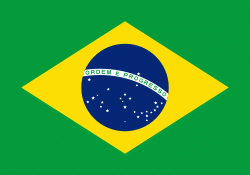Guarapuava
 |
 |
Guarapuava is located at 25°23'36" south and 51°27'19" west. The region is known as the centre of the state of Paraná, in the third plateau, also called the Plateau of Guarapuava. Discovered by the Portuguese in 1770, and founded in 1810, the city's name comes from tupi guarani, meaning place of Maned wolves sound (Maned wolves are called Lobos-guará in portuguese). Its elevation is 1120 m (3675 ft).
The first families to settle in the city were formed through the Tropeiros. These families had their roots in Poland, Italy and Germany. The city's birthday is celebrated on December 9, due to the beginning of colonisation between Rio Coutinho and Rio Jordão, in the goodwill of Nossa Senhora de Belém in 1819.
The city is the seat of the Roman Catholic Diocese of Guarapuava.
Discovered by the Portuguese in 1770 and founded in 1810, the city name derives from the Língua Geral of São Paulo agûarápuaba, meaning "place of Maned wolves sound" (gûará, Maned wolf + pu, sound/noise + aba, place). The city has the commemorative date of the anniversary date of December 9, due to the onset of colonization between Rio Coutinho and the Rio Jordão in the parish of Our Lady of Bethlehem in 1819, with the demarcation of village and church.
This location was chosen to start because of colonization at the time had a predilection to take up the field, with broad horizons, that through this natural feature, offering ease of defense against the Indians.
The first villages started up near Jaguariaíva, Pirai, Furnas, Castro, and Iapó Pouso of Ponta Grossa. Cities formed along the long path south until you come near the region where it is today the City of Guarapuava.
Its urban area has important role in its initial phase of Chagas Father Francisco Lima, who has started the occupation, based on some criteria of aesthetics, looking for the requirements contained in the charter of April 1, 1809, Count of Linhares, already determined that the standards to be followed by the buildings to be built. As for the point-core refers to Cathedral of Our Lady of Bethlehem, located at the top of the River Basin Cascavel, which was an important reference point for society of the time. The first mayor of Guarapuava was Colonel Pedro Lustosa de Siqueira.
In the year 1852, on July 17, the town of Our Lady of Bethlehem, was elevated to the category of town. On May 2, 1859 the district was created in Guarapuava, and José Antônio Araújo Vasconcelos of the first court of law. The Town of Our Lady of Bethlehem received annual city on April 12, 1871, by Law No. 271. Being separated from the municipality of Castro.
Map - Guarapuava
Map
Country - Brazil
Currency / Language
| ISO | Currency | Symbol | Significant figures |
|---|---|---|---|
| BRL | Brazilian real | R$ | 2 |
| ISO | Language |
|---|---|
| EN | English language |
| FR | French language |
| PT | Portuguese language |
| ES | Spanish language |

















